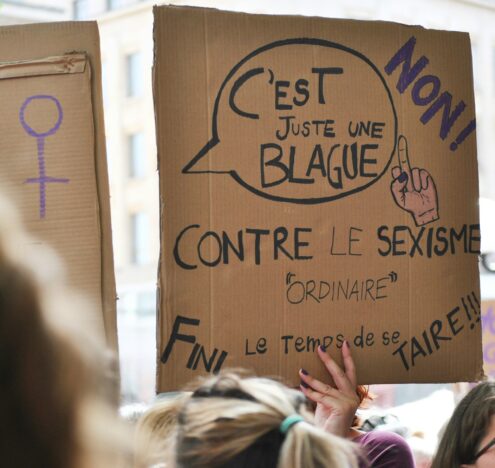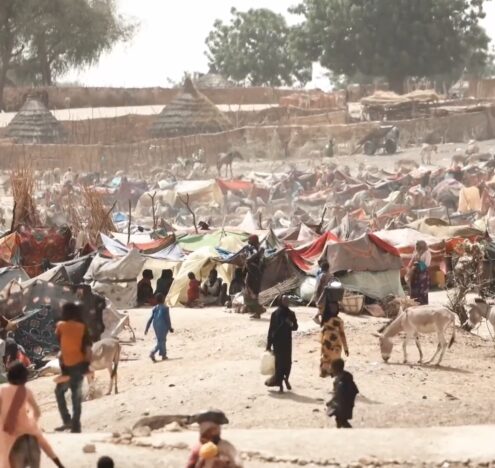Climate change impacts everyone on the planet. The ongoing COVID-19 pandemic has placed additional stress on our communities and our economies, making both increasingly brittle with each passing day.
Women and girls in low- and middle-income countries already face stigma and discrimination — and the global climate crisis furthers this by having immediate and long-lasting impacts on their sexual and reproductive health and rights (SRHR). SRHR includes the rights of all individuals to enjoy overall well-being in relation to all aspects of one’s sexuality and reproduction, including the right to have safe and pleasurable sexual relationships, make autonomous decisions regarding one’s body, and access the services that support that right. A report by Women Deliver, published earlier this year, found that those who are disproportionately impacted by climate change and its effects are the same populations that already experience limited access to SRHR services. Why is that?
The relationship between SRHR and climate change is largely unexamined and misunderstood. But it need not be.
IMPACT ON ACCESS AND OUTCOMES
We do know that climate change not only exacerbates existing inequities (like gender inequality) that limit people’s access to SRHR, but that climate change also negatively impacts people’s sexual and reproductive health (SRH) outcomes. Similar to SRHR, SRH encompasses well-being in all matters related to sexuality and reproduction. This includes, but is not limited, to: contraceptive choice; maternal and child health services; human immunodeficiency virus (HIV) and sexually transmitted diseases (STI) prevention, care, and treatment; comprehensive sexuality education; safe abortion care; and prevention, detection, and counseling for gender-based violence.
In the United States, we saw how climate change disrupted the lives of thousands when ice storms in Texas led to massive power outages across the state, and contributed to the deaths of more than 111 people from hypothermia alone. What happened in Texas, however, is also a clear example of climate change’s impact on SRHR. Over the last few years, people’s access to SRH services has become increasingly limited in Texas due to repressive laws making it difficult for Medicaid recipients to access basic SRH services, few abortion clinics and providers, and extensive restrictions on accessing abortion, including in-person counseling designed by the state to discourage abortion; a mandatory 24-hour waiting period necessitating multiple visits; and a required ultrasound before every abortion procedure. This reality, coupled with the devastating ice storm that literally sealed people into their homes or forced them to evacuate to crowded pop-up shelters, created a reproductive health crisis that has continued long after the ice melted. For example, the crisis itself forced people to delay seeking abortion care before 22 weeks of a pregnancy. In the aftermath, clinics faced a challenge rescheduling thousands of missed appointments, which impacted patients seeking all types of SRH services.
Climate change’s impacts on SRHR access takes many forms: the deprioritization of SRH services in disaster and epidemic responses; a lack of access to SRH services after climate-induced displacement; the destruction of healthcare facilities during severe weather events; a loss of water and sanitation, shelter, food, and menstrual hygiene products after natural disasters; inability to access support services after experiencing gender-based violence (which is known to increase during and after climate crises); and a host of other issues.
Women and girls will not stop climate change with their reproductive capacity. Any approach to climate change that includes fertility control is unjust because such approaches place the burden of responding to climate change on the reproductive autonomy of women.
Hurricane Eta’s path of destruction through parts of Honduras in early November 2020 is a telling example. It impacted millions of people, forced thousands from their homes, and left over 400,000 women without access to essential health services. In the aftermath, the United Nations Population Fund (UNFPA) responded to rising cases of gender-based violence and distributed reproductive health kits, including menstrual hygiene supplies, to people across affected areas until health facilities could be reopened.
The climate crisis’s impact on SRH outcomes also manifests in a multitude of ways, including the increased geographic distribution and transmission of sexually transmissible infectious diseases with zoonotic origins (think: Ebola, Zika, and HIV); increased risk of child marriage as climate emergencies threaten financial security; an increased risk of preterm birth, low birth weight, and stillbirths as pregnant people experience greater exposure to air pollution and extreme heat; and many other, potentially life-threatening, impacts on people’s SRH. For example, periods of drought, which are occurring more frequently and for longer periods of time because of climate change, have a profound impact on the health of those in agricultural communities across the globe. Research in Lesotho found that HIV prevalence rose among women and girls in these communities due, in part, to an increase in transactional sex, which tends to occur as a means to mitigate drought-induced food and economic insecurity.
UNDERSTANDING AN IMPORTANT LINK
The connection between climate change and SRHR is not new. For decades, mainstream public health discussions about climate change and SRH have been centered around population control: slowing population growth in low and middle-income countries as a means to address climate change. Voluntary family planning continues to be touted as a “climate-compatible” development strategy by many public health and international development institutions.
Population growth cannot be ignored but neither can SRHR. Women and girls will not stop climate change with their reproductive capacity. Any approach to climate change that includes fertility control is unjust because such approaches place the burden of responding to climate change on the reproductive autonomy of women and those who can become pregnant in countries where individuals contribute the least to global carbon emissions. Population control embodies the neocolonial side of international development by applying a neo-Malthusian approach to reduce population growth, rather than tackling the corporations and high-income countries — including the United States — that contribute the most to climate change.
Make no mistake, many women and girls worldwide want and need access to modern methods of contraception to choose if, when, and how many children they want to have. Everyone has the right to access a range of contraceptive options, free from discrimination, violence, and coercion. Improving universal access to contraception is necessary and worthy, but human rights are at stake when access to contraception becomes a target solution for climate change.
LEADING THE CHARGE
Unfortunately, efforts to progress conversations, research, and policies about the intersection of climate change and SRHR have been stymied and stonewalled by elected officials who refuse to acknowledge that climate change is even real and have politicized and demonized SRHR. Furthermore, research that focuses on the impacts of climate change on the sexual and reproductive health of those who live at the intersections of other identities — namely LGBTQI+ folks, indigenous communities, and people with disabilities — remains limited. Progress, therefore, will continue to be hindered as long as federal funding is hung up on politicians with their heads stuck in the sand.
The encouraging news is that women and girls around the world are leading the effort to secure a rights-based response to the climate crisis. Environmental justice and reproductive justice activists who have been leading this work for decades — particularly Black women in the United States, Indigenous and Afro-descendant peoples globally, and frontline movement leaders everywhere — know that siloed thinking about climate change and SRHR ignores the lived realities of the communities and people who have been discriminated against across the globe, which has slowed progress on the implementation of rights-based solutions to both climate change and SRHR.
Addressing climate change and SRHR together requires an understanding of how global systems of oppression intersect to compound the inequities that already-discriminated groups experience. As conversations about the decolonization of global health gain traction, there is an opportunity to advance conversations about how people whose SRHR is most impacted by climate change are also those who bear the brunt of systems of oppression, like white supremacy, capitalism, colonialism, and all other forms of systemic oppression.
PRIORITIZING WOMEN’S AND GIRLS’ HEALTH
On this Earth Day, as President Joe Biden convenes global leaders for a summit to address climate change, we hope that the United States’ commitments will recognize the ways climate change impacts women, girls, and people who are socially, economically, culturally, politically, institutionally, or otherwise marginalized. Climate change solutions must go beyond discussions of adaptation, mitigation, and resilience and focus on human rights and the integration of the climate change and SRH sectors.
We can’t fight climate change without upholding sexual and reproductive health and rights for all.
Sammy Luffy, MPH is the Senior Policy Research Associate at the Center for Health and Gender Equity (CHANGE) where her research focuses on documenting the impact of US foreign assistance policies and programs on people’s sexual and reproductive health and rights globally.
Samhita Rao, MA is a former Policy Research Intern at CHANGE who is passionate about researching the intersections of climate compatible development and sexual and reproductive health and rights globally.





















